Background
There are about 40 limestone and dolomite quarries in south-western Ontario but only a few of them have produced significant mineral specimens. All of them have some vugs of varying sizes with simple calcite or other crystals but only a few have fine, larger, well crystallized minerals such as fluorite, celestine, sphalerite, calcite, marcasite, gypsum, pyrite and pyrite ps pyrrhotite. Rock outcrops are, actually, relatively uncommon due to a thick covering of glacial till but there are also a few miscellaneous non-quarry occurrences of well crystallized minerals in the Paleozoic sediments of southwestern Ontario and I’ll touch on these in this article.
The quarries in south-western Ontario produce limestones, dolostones and shales for a number of purposes such as aggregate, lime and cement production, armour stone, flagstone, building stone and many other uses. Usage is related to the chemical composition and/or physical properties of the rock. Some of the sediments are pure enough for use in chemical or cement plants while others are suitable only as aggregate in concrete, asphalt, road fill, etc.
Geology
The surficial rocks of south-western Ontario were, originally, shallow ocean-marine sediments, laid down in Paleozoic times, and later transformed to limestones, sandstones and shales. Some of the limestones, in turn, eventually underwent dolomitization (changed from, predominately, calcite to dolomite due to percolating magnesium rich brines) (Wolf, 1993) and were transformed to dolomite or dolostone.
Sub-economic concentrations of Mississippi Valley-type lead and zinc mineralization occur in many of the dolostones of the region. Probably about 250 million years ago in geological history, warm brines circulated through metal bearing shales in the sedimentary sequences, dissolving metals such as zinc, lead, sulphur, iron and strontium and eventually precipitated sulphide and sulphate mineralization into voids in the dolostones or even replacing parts of the dolostones. (Wolf, 1993)
Some of the sediments contain hydrocarbons and they can be observed as black bitumen in rock cavities and joints, sometimes enclosing or coating mineral crystals and sometimes included in them.
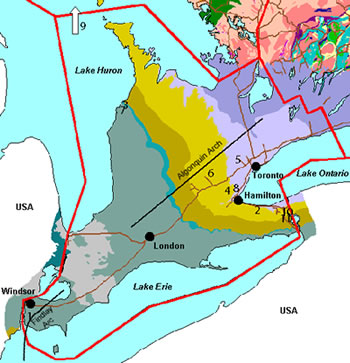
Amherstberg, Maldon Township, Essex County Unfortunately, this quarry, located just outside of Amherstburg is not currently operating. In the 1970’s, very nice specimens of celestine and calcite were recovered from this operation. The crystals are not large but nice up to 20mm or so. Native sulphur in poor crystals, was also found there.
Beamsville Quarry, Clinton Township, Lincoln County This is another old classic location for south-western Ontario collectors and has been a source of nice sphalerites and calcite specimens for many decades. The sphalerites, up to 15mm, can be beautiful and very orange in colour but are usually red-brown to brown. Many nice specimens of “dogtooth spar” calcite crystals, crystals up to 20mm or so, have been collected here over the years. Fluorites, to 22mm in size, do occur, usually colourless to light lavender but they have not been particularly notable. Galena crystals and other minerals occur here but tend to be small, mostly in the micro range.
Canal Dumps, Niagara Falls Canals for hydro generation at Niagara Falls had to be blasted. Some rock that was blasted from the excavations was trucked away from the site and piled in nearby fields (Wilson M. 2012). The two main accessible rock dumps were adjacent to Lundy’s Lane and Montrose Road in Niagara Falls. Over the years, the rock has been used for various construction purposes, armour stone, rock fill, road construction, etc. Some of the rock, from the excavations was from layers of dolomitic limestone that contained excellent fluorite and sphalerite crystals. Excellent crystals of these minerals can still be found in boulders in the remnants of these rock dumps. You’ll often see these specimens listed from “Montrose Road Dumps” or “Lundy’s Lane”.
The fluorite crystals, arguably, are the most desirable of all of the limestone occurrences in south-western Ontario. The best are ultra-gemmy, lustrous, deep blue or purple and up to 35mm or so in size, although most are less that 25mm on-edge. More commonly, they are light lavender to colourless. The specimens can be extremely aesthetic with the gorgeous fluorite crystals contrasting against the brown, rough limestone. Interestingly, the fluorite crystals exhibit dichroism and change colour depending on the type of light they are viewed in: fluorescent light –blue, incandescent light –purple (Mielke, R. 2012).
The sphalerite crystals can also be very nice here. They range in colour from gemmy beige to gemmy-deep-red or orange and range in size from micro to 30mm.
Some other minerals that can also be found in well formed crystals are calcite(to 20mm), marcasite, anhydrite (aggregates filling cavities to 100mm) and sulphur( less than 5mm) crystals.
Unfortunately, over time, these old rock dumps have been levelled and/or hauled away. This area has become urbanized, with industrial and residential development closing in on the old dumps. During 2011, the last bit of dump was levelled and covered by “big box” stores, thus ending a wonderful mineral collecting opportunity.
Dolime Quarry, Guelph: This quarry has only become popular in recent years and has become a source for nice sphalerite crystals. I, personally, have not collected at this quarry but have seen some excellent specimens with large, complex sphalerite crystals to 50mm across, associated with small calcite crystals. The crystals are usually a dark brown to bright orange to dark-brown with good lustre. Some sphalerite is gemmy and has been facetted.

Douglas Point: When the nuclear power station was built at Douglas Point, rock was excavated for some of the facilities. The excavation of the spillway for water from the plant revealed cavities of well-formed, gray celestine crystals to 50mm or so. This was a one-time occurrence and the time to collect was short so only a relatively few specimens were recovered.
Flamboro Quarry, West Flamborough,Wentworth Co.: The geology and mineralogy at the Flamboro Quarry is very similar to that of the Lafarge Quarry (described below). They are only a few hundred metres apart and are working in exactly the same strata - Silurian dolostones of the Guelph and Lockport formations. However, there are subtle differences between the two quarries. In general, the sphalerite at Flamboro seems more lustrous and gemmy than the sphalerite at Lafarge. As well, the fluorite crystals at Flamboro can be a bit more brownish, sometimes with an outer phase of light lavender fluorite while this is less common at Lafarge. At the time of writing, the quarry is closed on weekends and, thus, no collectors are allowed to collect. This has effectively shut down organized collecting at the Flamboro quarry.
The fluorite crystals from this quarry can be superb. They are simple cubes to 30mm, clear to colourless but usually tinted brownish, possibly due to inclusions of hydrocarbons. The crystals can be found as single crystals on matrix, scattered crystals and clusters on matrix and as tightly packed crystals lining vugs. Fluorite at Flamboro quarry is often associated with orangey-brown sphalerite crystals. As at Lafarge quarry, the fluorite is usually in large boulders of very hard rock and recovery can be difficult.
The sphalerite at this quarry can be fabulous. It is commonly found as smaller, 2-5mm crystals but can also be found in gemmy, complex, twinned aggregates to 100mm in size. Colour ranges from pitch black to a gorgeous burnt-orange colour.
Recently, very nice galena crystals have been found at Flamboro with well-formed crystals up to 25mm or so. Crystals usually show the cube as the predominate form but some are modified by octahedral and dodecahedral faces.
Modest specimens of calcite(to 60mm), gypsum in complex crystals to 1400mm, marcasite to 15mm and other minor minerals have also been found at the Flamboro Quarry. Interesting round “balls” of calcite crystals to 10mm, or so, are often found at this quarry. Despite its proximity to the Lafarge quarry, celestine crystals, to my knowledge have not been recovered there.
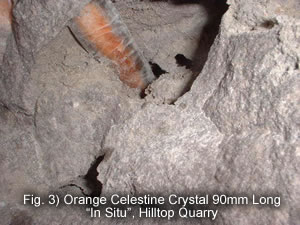
“Forks of Credit” Area: In this area, there are or have been a number of quarries and natural exposures that expose layers of limestone that have open spaces filled or partially filled with bright orange celestine at the contact between the Lockport dolomites and Whirlpool sandstones (Sabina, 1965). Why is it orange? Maggie Wilson pointed me to the American Mineralogist, Volume V64, p160-168, 1979 which explains that the orange colour in celestine is caused by the presence of copper (Wilson, M 2012 ). Single crystals are rare and vug fillings tend to be semi-radiating, closely compacted aggregates up to 100mm or so. I’ve not seen well terminated crystals from this location and single crystals tend to “bridge” vugs. The specimens are unique and there is usually one in most southern Ontario collectors’ collections. Some small marcasite and calcite crystals are sometimes associated with the orange celestine. At some locations, particularly the Deforest Quarry, the presence of significant copper has resulted in malachite being formed, sometimes in micro-crystals (Wilson M., 2012).
High Falls, Manitoulin Island: Interesting geode-like nodules were once available from the Paleozoic sediments at High Falls on Manitoulin Island. These nodules are sometimes hollow and are lined with crystals of calcite, dolomite, celestine and chalcopyrite. Apparently, there is an overhang of rock at the site, which can be very dangerous. I am told that the locality was exhausted many years ago and is currently off-limits to collecting on private land (Benoit G. 2012, personal communication).
Inverhuron: Very well formed crystals of calcite occur in cavities in limestone on the shore of Lake Huron, just north of the town of Inverhuron, Ontario The strata with the calcite crystals is at lake level or below high water level most years. When the water level in Lake Huron is low, the strata with the crystals is at or just above the water level and then it is fairly easy to access them. The calcite is unique and shows twinning on 0001 plus interesting hoppered faces. The best crystals occur in clay filled openings and they are gemmy and clear. Crystals that occur in openings not filled with clay tend to be slightly frosted. As well, balls of radiating white strontianite crystals to one centimetre occur with the calcite in some areas. There are a couple of zones where 10mm or so sharp, icy-blue celestine crystals can be found. Unfortunately, the occurrences are now within the boundaries of an Ontario Provincial Park (Inverhuron) and collecting is probably not allowed.
Lafarge (Dundas) Quarry , Wentworth County: This quarry has had several owners over many decades and has been known variously as the “Dundas” , Redlands, Steetley and, most recently, the Lafarge Quarry. It is the “grand-daddy” of the quarries and has operated for many decades. It is huge in size and is really composed of three large excavations, two of which are finished. The quarry started out on the south side of Highway 5 but a new quarry was started on the north side of the road and connected by a tunnel blasted beneath the road. Rock is now blasted and crushed in the third quarry and transported south to the distant processing and shipping plant by overland conveyor.
People, beginners and seasoned collectors, have been visiting this quarry to collect fine mineral specimens for many decades. There are various types of open spaces where well-formed crystals occur. Many of the open spaces are stromatolites or other fossils, while others are random openings or faults/joints in the limestone. The “vugs” can be up to 2m across! These openings are the favourite place to find excellent celestine, fluorite, sphalerite and calcite. There are many veins of calcite up to dozens of metres long that cut through the limestone, many of which are large and contain abundant openings of calcite. There are also veins of sulphides (marcasite, galena and sphalerite) that are fairly massive, in a couple of places in the quarry.
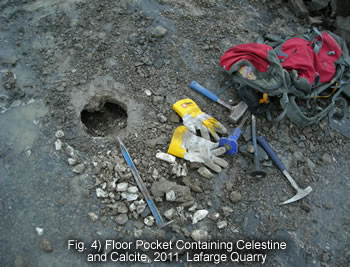
The Lafarge quarry is probably most famous for the celestine crystals that occur in the lower layers of rock at the quarry. Quarrying is not always done in the lower layers strata and so celestine is not always available. Long stretches have gone by with no celestine being found. The celestine crystals are found in many habits including large simple prisms to 150mm, large prisms with multiple terminations, small, milky, doubly-terminated prisms, scattered on matrix and smaller gemmy doubly-terminated crystals. Colour ranges from colourless to milky white to sky blue and crystals can be highly lustrous or dull-opaque. The larger crystals are almost always loose in the pockets having been jarred from the vug walls by blast vibrations. The larger crystals almost always have micro marcasite crystals included in them and, on occasion have calcite or galena crystal on their surfaces. Celestine sometimes occurs with gypsum.
The fluorite at this location tends to be amber to colourless, simple cubic crystals up to 100mm on-edge but normally more like 10-30mm or smaller in size. Lustre is usually excellent. The crystals are, however, often in tight vugs in the hardest rock in the quarry and so can be very difficult to extract intact. Fluorite is often found in the long rows of armour stone that is set aside for use in breakwaters or other barriers. Fluorite occurs, most commonly with sphalerite, marcasite and calcite. Interesting specimens have been recovered showing fluorite crystals embedded in hard, black hydrocarbon.
Sphalerite is usually red-brown to brown to black and almost always in complexly twinned crystals to 35mm or aggregates up to 100mm or so across. It occurs with fluorite, calcite and marcasite crystals. Sometimes the sphalerite crystals can be highly iridescent. Some sphalerite is gemmy and has been facetted.
Galena is a relatively rare mineral at Lafarge quarry, at the present time. Although it does occur in crystals up to 25mm usually it is in crystals less than a few mm. In the 1960’s, a thick vein of sulphides was exposed in the south quarry and excellent specimens of galena crystals to 10mm, or so, on marcasite or sphalerite were recovered by R. Mielke and his father (Mielke, R. 2012, personal comm.). Unfortunately, the marcasite from this vein occurrence is not stable. Crystals of marcasite on limestone, to date, seem stable (Mielke, R., 2012)
Gypsum is rarely (relatively) found at this quarry in large water clear crystals in limestone vugs. The crystals usually fill all or much of the void and well terminated crystals are not common. Large, up to 120mm, highly striated part crystals are more commonly recovered. Gypsum can occur with celestine and interesting specimens have been recovered with celestine crystals fully embedded in the water clear gypsum.
Recently some sharp marcasite pseudomorph after pyrrhotite crystals up to 2cm have been found but these are rare. Excellent “cockscomb” marcasite and individual crystals of marcasite to 20mm have been recovered. Other minerals that are occasionally found include strontianite in white botryoidal crusts and micro crystals and micro sulphur crystals.
Collecting status at this quarry is currently in jeopardy. Safety infractions by people on organized club-field trips in the past few years have strained relations with the quarry management and collectors are worried that they may not be allowed to visit this amazing old quarry. Let’s hope that this does not happen. It would be a tragedy to lose collecting privileges at this prolific site. Walker Brothers Quarry, Niagara Falls: The Walkers Brothers Quarry was a stalwart specimen producer many years ago and nice specimens are still seen from time to time on the swap tables. It was well known for its water clear gypsum crystals, creamy, curved dolomite crystals and small sphalerite crystals.
Collecting
It is possible to collect at some of these localities but collecting is usually limited to organized Gem and Mineral Club field trips at the operating quarries. The big quarries are operated by multinational companies who take trespassing and safety very seriously! You should endeavour to join a club in the area and then it will be easy to be notified of and participate in field trips when they occur.
Mineral Specimen Images
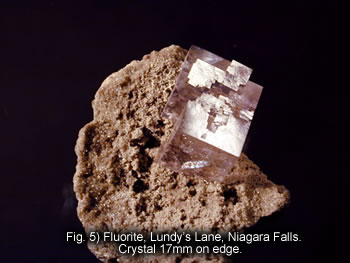
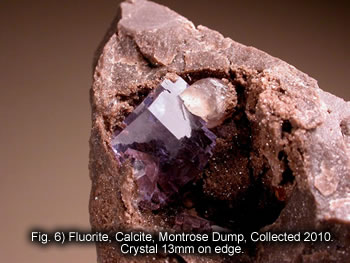
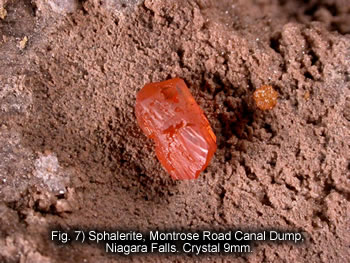


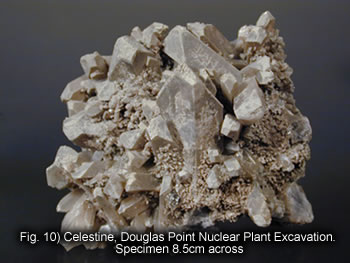
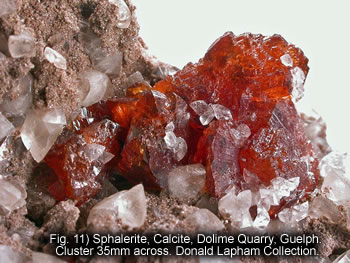




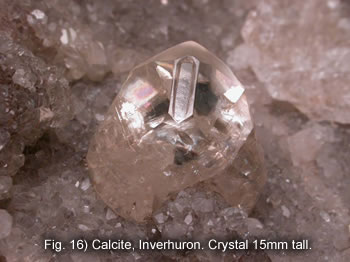
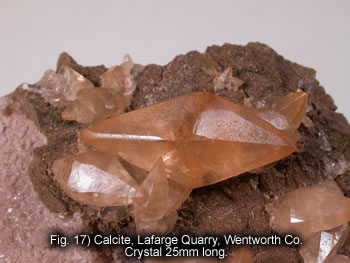
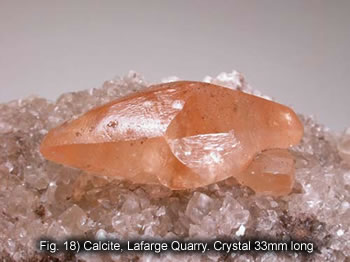
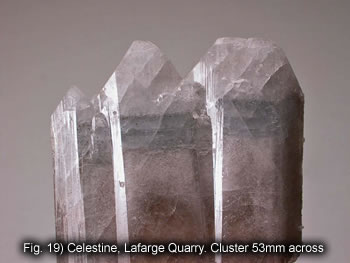
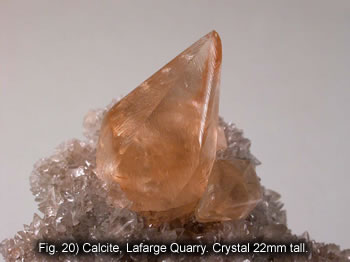


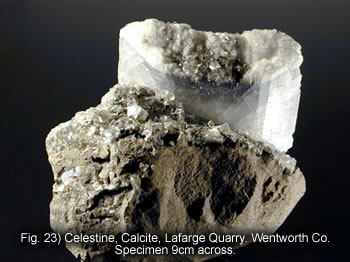
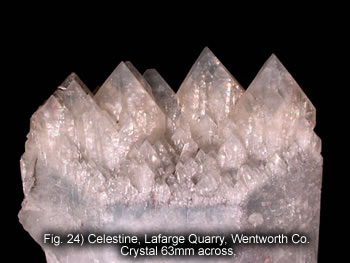
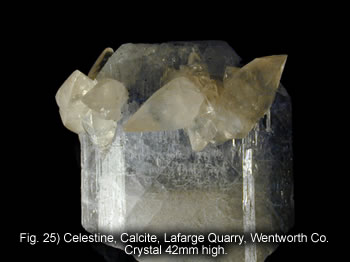


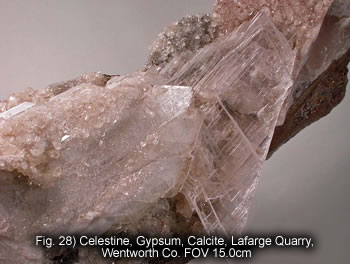
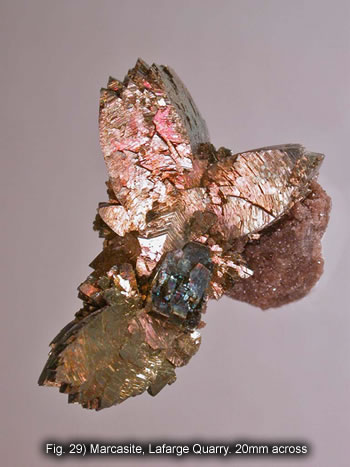
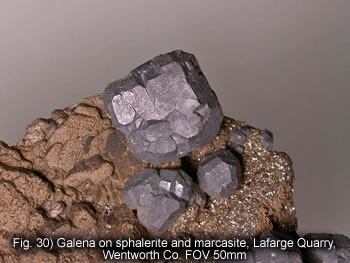



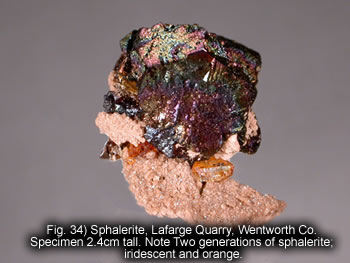
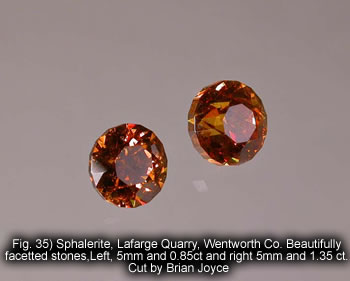

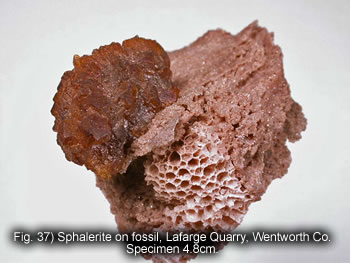
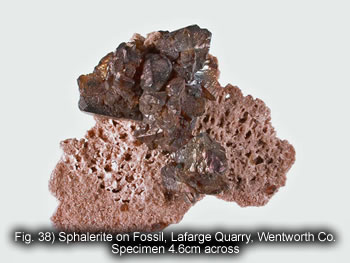
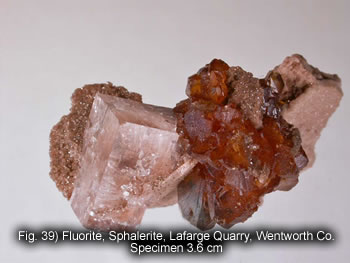
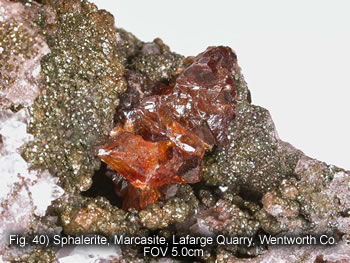
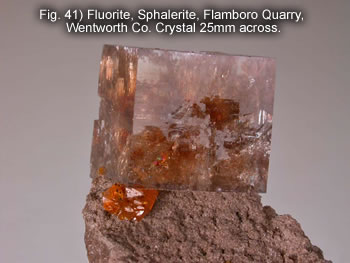

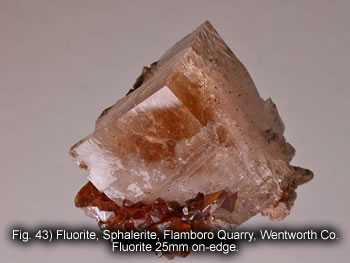


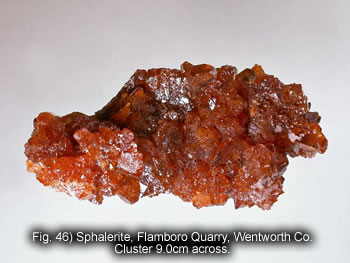


These are the most visited mineral occurrences that I know of in the Paleozoic Rocks of southwestern Ontario. Of course, the rocks do not recognize political boundaries and there are similar, related occurrences in the USA. I’m sure there are other occurrences, not mentioned here, that are not as prolific or well known and I expect there will be new localities in the future. Let’s hope so!
Acknowledgements
hanks very much to Ray McDougall, Margaret Wilson and Reiner Mielke who reviewed this article and offered very useful improvements based on their experiences collecting in southwestern Ontario. Thanks to Don Lapham who provided information about Guelph Dolime quarry, site images and access to his sphalerite specimens from that locality for photography. I appreciate the high-quality faceted stones pictured in the article gifted to me by my brother Brian Joyce, who cut them.
All mineral specimens featured in this article are or were from the collection of David K. Joyce, unless noted otherwise.
References and Further Reading:
Benoit, Gilbert 2012, personal communication
Joyce, David K. www.djoyceminerals.com, “Recent Activities” –several entries
Mielke, Reiner, 2012, personal communication
Sabina, Ann P. 1963, Rock and Mineral Collecting in Canada Ontario and Quebec, Volume II, Misc. Report 8, Geological Survey of Canada, Page 132
Wilson, Margaret 2012, personal communication
www.mindat.org There is detailed info on some of these localities in mindat.org
Wolf, R.R. 1993. An inventory of inactive quarries in the Paleozoic limestone and dolostone strata of Ontario; Ontario Geological Survey, Open File Report 5863,272p.